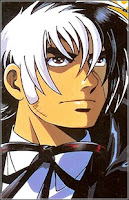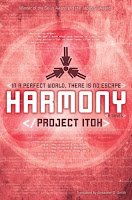 Author: Kaoru Kurimoto
Author: Kaoru Kurimoto
Illustrator: Naoyuki Kato
Translator: Alexander O. Smith and Elye J. Alexander
U.S. publisher: Vertical
ISBN: 9781932234817
Released: December 2007
Original release: 1979
Awards: Seiun Award
The Leopard Mask is the first book in Kaoru Kurimoto’s epic light novel series The Guin Saga. Kurimoto began the series in 1979 and as of the author’s death in 2009, she had published one hundred forty-seven Guin Saga novels, making it one of the longest works written by a single author. So far, only the first five novels of The Guin Saga, consisting of the first major story arc, have been released in an English translation. The Guin Saga, Book One: The Leopard Mask, translated by Alexander O. Smith with the assistance of Elye J. Alexander, was first released by Vertical as a hardcover in 2003 and then in a paperback edition in 2007. The English releases include the wonderful illustrations by Naoyuki Kato. In Japan, The Guin Saga is a very popular and highly influential work. I have seen numerous authors, mangaka, and creators cite Kurimoto and the series as a source of inspiration for their own work, including Kentaro Miura and his manga series Berserk. Additionally, The Guin Saga received a Seiun Award in 2010 for Japanese Long Fiction.
Twin brother and sister Remus and Rinda are the last remaining members of the royal house of Parros. Wandering the extremely dangerous Roodwood on their own in an attempt to escape their pursuers from the Mongauli army, they come across a fierce and frightening warrior. The man is nearly naked, wearing only a loincloth and a strange mask shaped like head of a leopard that seems to have been magically affixed to his own and which he is unable to remove. He has no memories of who he is, where he comes from, or why he is injured and alone in the Roodwood. He remembers two words: Guin, which he believes to be his name, and Aurra, which remains a complete enigma to him. But no matter who Guin really is, he may be the only chance for the twins survival.
At least for me, the most interesting character by far is Guin, even though hardly anything at all is known about him. The mystery shrouding Guin and his past intrigues me, not to mention his form and martial capabilities. One thing that did bother me, and something that Remus comments on about halfway through the novel, was that for someone claiming to be an amnesiac, Guin tends to remember some fairly important information when it’s convenient for the story. I have a feeling and hope that this may be further explained in later volumes. I found the twins to be slightly annoying; Rinda especially comes across as somewhat of a spoiled brat. I liked most of the side characters, particularly Istavan and Orro, even if he did gain and lose his accent from one appearance to another. Towards the end of The Leopard Mask, Kurimoto does some really nice things with the character of the Black Count, who is more complex than he might first appear. Characterization in the novel is mostly based on the character’s actions and reactions rather than really getting to know their thoughts or feelings.
The Leopard Mask is a good hook for the rest of the series, introducing the world and characters, but it doesn’t stand as well on its own; it really seemed more like a prologue to me. The prose can be overly dramatic at times, but that is more an indication of the genre rather than the fault of the translators. (In fact, I think that Smith and Alexander did a fine job with the translation.) It’s almost as if the story would be best read aloud or performed. The action and fight sequences are particularly well done and exciting. Kurimoto does have a tendency to “rewind” the chronology from scene to scene and sometimes it can be difficult to get a good sense of the passage of time. The best descriptions in the text are reserved for Guin as well as for the other freakish and bizarre things in The Leopard Mask. Overall, the world has a very dark atmosphere to it. While I eventually enjoyed The Leopard Mask, I wasn’t really taken with the book until close to the end. However, I’m still looking forward to giving book two of The Guin Saga, Warrior in the Wilderness, a try.









